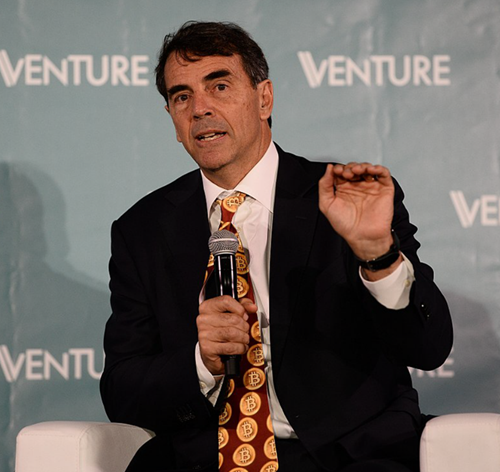
The world's leading cryptocurrency is sagging under the same pressure of the record-breaking inflation that is plunging the S&P 500 and Nasdaq. The U.S. Consumer-Price Index (CPI) has shown a bleak 9.1% jump in inflation year-over-year, the highest in more than 40 years.
The Federal Reserve is moving to tighten monetary policy, which creates more uncertainty in cryptocurrency, and demand for Bitcoin (CRYPTO: BTC) has dropped. Bitcoin has lost 70% of its value since its all-time high of $69,000 in November 2021. According to Coinmarketcap, Bitcoin's market cap has dropped from nearly $800 billion to under $400 billion.
Billionaire investor and "adventure capitalist" Tim Draper has had an enviable run identifying and betting on the technology that shapes our future. Draper has invested in a series of famous successes in tech, including Baidu, Hotmail, Skype, Tesla, SpaceX, AngelList, SolarCity, Ring, Twitter, DocuSign, Coinbase, Robinhood, Ancestry.com, Twitch, Cruise Automation and Focus Media. Draper is a staunch supporter of Bitcoin and has made long-term price predictions he stands by.
In 2014, Draper predicted Bitcoin would reach $10,000 within three years — it did in November 2017. In 2018, when Bitcoin hung around $8,000, Draper made what seemed a hyperbolic prediction at that time, saying it would reach $250,000 by the end of 2022 or early 2023.
Even in the chilly climate of this crypto winter, Draper stands by his prediction. We interviewed Draper on our Benzinga web show, Web3 Anarchy, a few days ago and are sharing his insights here. As always with Draper, the big picture isn't just following the numbers — it's about considering the technology behind the price and its potential to change the world for the better.

BZ: Was this dip in Bitcoin and other cryptocurrencies predictable?
"I think this was somewhat predictable. Because when there's inflation, then the Fed has to raise its interest rates. So the stock market will fall. And with it will go all the speculators out of the crypto world."
What impact do you expect the crypto bear market to have on the blockchain world?
"I think that what we've got left in the crypto world are the other true believers. And all a lot of the speculation has come out of it. And the true believers are thinking, yes, this is the future, in particular, Bitcoin is the future of currency, the future of banking, the future of finance. I'm a believer that we were about to go through an anthropological leap. We almost had it with the internet. We almost had the leap with the Internet. But then, when cryptocurrencies showed up, the governments decided they would go back to being control freaks instead of allowing the freedom that they need to allow."
What do you mean by an "anthropological leap" forward?
"We've got an uphill battle right now, but in the long term, the technology always wins out. I think we're going to see a real change in the way the world works.
I can imagine a time when I can raise a fund all in Bitcoin, invest it all in Bitcoin, and have entrepreneurs pay their employees all in Bitcoin, and offer all of that on a series of smart contracts that keep perfect records. Those entrepreneurs have perfect visibility into what's happening in their businesses because the accounting happens in real-time. The taxes are paid in real-time.
There are so many things that can be done better now that we have Bitcoin."
You don't think a clear regulatory framework is needed to stabilize the crypto market?
"By the time the U.S. government has a regulatory framework, we are going to be 40 years behind El Salvador. I met a bunch of government officials from El Salvador working with the president on their Bitcoin strategy. I was jealous. I could not believe how far advanced they were in their thinking. They've got smart contracts everywhere. They have people paying with Bitcoin, paying their taxes with Bitcoin, and the system is working.
That government will be 40 years ahead by the time we get some regulatory framework for this. We've got a bunch of 70-year-olds sitting around talking about something they know nothing about."
Don't you think that Nancy Pelosi gets Bitcoin?
"I don't think she has Bitcoin. It's not just Nancy. The whole senate is 70 years old. And the average owner of a Bitcoin wallet is probably 30.
The good news is that people my age are dying off. And this 30-year-old group is going to change the nature of the world. The world's going to open up. We're going to have a decentralized world. The borders are going to crumble over time, and people will be able to move from country to country very easily. And eventually, we'll all be citizens of this great world, and we'll have a currency that can be used anywhere."
Isn't price volatility a challenge to the usability of Bitcoin as a currency?
"One bitcoin is still worth one Bitcoin. It always will be. It's not Bitcoin that's volatile. It's the other currencies … and there's a huge move away from fiat. When I can buy my food, clothing and shelter in Bitcoin, then there'll be no reason for anyone to hold on to a currency that inflates and is tied to government whims, and is controlled by a and is only available in that country and only useful in a number of countries, but not all of them. Bitcoin is frictionless, decentralized, and controlled by no one."
In 2018, when Bitcoin was right at $8,000, you predicted that it would reach $250,000 by the end of 2022 or early 2023. Are you still sticking to that prediction?
"Yes, absolutely. In 2014, Bitcoin was at $180, and I predicted on Fox Business News that Bitcoin would hit $10,000 in three years. Three years later, almost to the day, Bitcoin hit $10,000. Then Bitcoin dropped down to $4,000 in 2018, and I made the prediction of $250,000 by 2022 or early 2023. I'll stand by it.
Women control 80% of the retail spending. And they only have about one out of every six Bitcoin wallets now. It was one in 14, and now it's one out of six. There will be a moment when retailers say, wait, no, we want your Bitcoin ... And once that starts to happen, there will start to be a run on the fiat currencies, and $250,000 might be conservative."
Do you see this as an instance where traditional finance is dragging down crypto?
"There are always going to be a lot of cycles and people jumping in and then jumping out when you have a trend that is really taking off. You'll see Bitcoin, and all sorts of cryptocurrencies bounce up and down. And there'll be speculation that this is the end of the world. Whenever you start hearing that stuff in the press, that's when you go in big."
Do you have any advice for investors hit hard by the downturn?
"What can give you hope is the dot-com bust felt like the end of the world, and some of the greatest companies in the world came out of it. I think the same kind of thing is going to happen with Bitcoin."
Summary
Draper brings the point of view of a true believer in technology to investing. He goes beyond the simple rise and fall of prices to look at the potential of projects based on how they might help people lead better lives. It's an important perspective to consider, or the companies you buy into, inside and outside the crypto world, become anonymous strings of names and tickers or coins.
While many would be surprised to see Bitcoin take a meteoric rise to $250,000, that indicates nothing more than that the potential Draper is betting on has yet to be realized. To be honest, it took vision to see a $10,000 or $69,000 price for Bitcoin. If his 2018 prediction is as reliable as his 2014 prediction, we are in for a wild, world-changing technological ride.
Cover image by Perez Vöcking from Pixabay.







